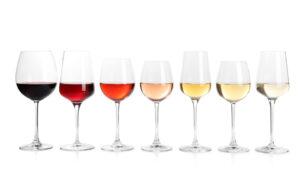The acidity of a wine determines how well it will pair with food—but labels often say nothing of this crucial information.
Facing a wall of wine bottles in a store can be daunting since we don’t know what kind of wine we’re going to get, even if we think we know something.
The problem is exacerbated by wineries around the world that seem pleased to tell consumers nothing about their wines. Labels are a good place for data, but they often end up saying something so vague that it means nothing.
“Long ago our family decided to make world-class wine, and this bottle represents the dedication of many people who are committed to quality. We use only the best grapes, and we make wines that we hope you will enjoy.”
This isn’t a real back label. But it represents a lot of the vagueness I see and a wasted opportunity to tell consumers something meaningful.
Most wineries think of all wine consumers as idiots. And to be sure, lots of wine drinkers couldn’t care less about the acid and alcohol in the wine. All they care about is, “Will I like it?” And winemakers everywhere answer that question in precisely the same way: “Sure. Trust me.”
But alcohol and acid can tell you something about the wine, and most people who care about such things are left completely in the dark. Here are a few basics:
Alcohol: Higher alcohols in a wine make it sweeter on the tongue. Lower-alcohol dry wines may be appealing as aperitifs and work nicely with spiced foods, such as Asian and Mexican.
I find that the best structured wines have about 13 percent alcohol. At 14 percent, wines tend to have more body and richness; at 15 percent, they tend to be clumsy and not very interesting with most foods.
Acid: The higher the acid is, the crisper the wine will be. Thus, wines with slightly more acid will be better with food.
About 99 percent of the wineries in this world reveal nothing about the acidity. So, any advice I could provide would be lost in the fog of obfuscation. But in general, higher acid wines are excellent with food; low acid wines usually are terrible with food.
A few examples will suffice.
California zinfandel: If you can find one under 14 percent alcohol, it might work nicely with pizza. Over 16 percent? Ugh.
New Zealand sauvignon blanc: It typically has high acid, so you might think it would work with food. But most are sweet, so they would work best with spicy foods.
California sauvignon blanc: Since they typically have less acidity than New Zealand ones, most are drier.
Chianti: This lighter Italian red wine has sufficient acid to match nicely with tomato-based foods such as pastas with sauce. Alcohols typically are about 13.5 percent.
California merlot: This medium-weight red usually offers generous fruit and rarely has much astringency. At lower prices, they’re probably best served slightly chilled since so many are a bit sweet.
Côtes du Rhône (red): Once, decades ago, this lighter-weight French red was dry, but recently it has become more succulent. It’s usually best after decanting for about an hour.
Cabernet sauvignon: At lower price points, this flagship red from California today is a simple, soft, not-very-interesting walking-around wine. It once was a dry wine best served with hearty meat dishes. Most cabernets today are simply too low in acidity for me.
As you might have guessed from the foregoing, wine styles are in flux. What’s fashionable today often has no relation to wines of the past. Part of this is due to climate change, but it’s also due to trends prompted by wine critics’ scores.
If there is a message in this, it is simply that wineries are failing the consumer by not providing any technical details to allow for appropriate buying decisions.
Wine of the Week
2019 Tenuta Perano Chianti Classico Riserva DOCG ($24): A little of the old-world style is here with traces of iron ore, tart cherry, and fresh plums, with a rich midpalate and good acid. From the large producer Frescobaldi, it is also new-world in style, so younger buyers will like its richness. But we are all different, and its 14.5 percent alcohol was slightly high for me. I liked it better with a teaspoon of water added.Dear Readers: We would love to hear from you. What topics would you like to read about? Please send your feedback and tips to [email protected]. 






